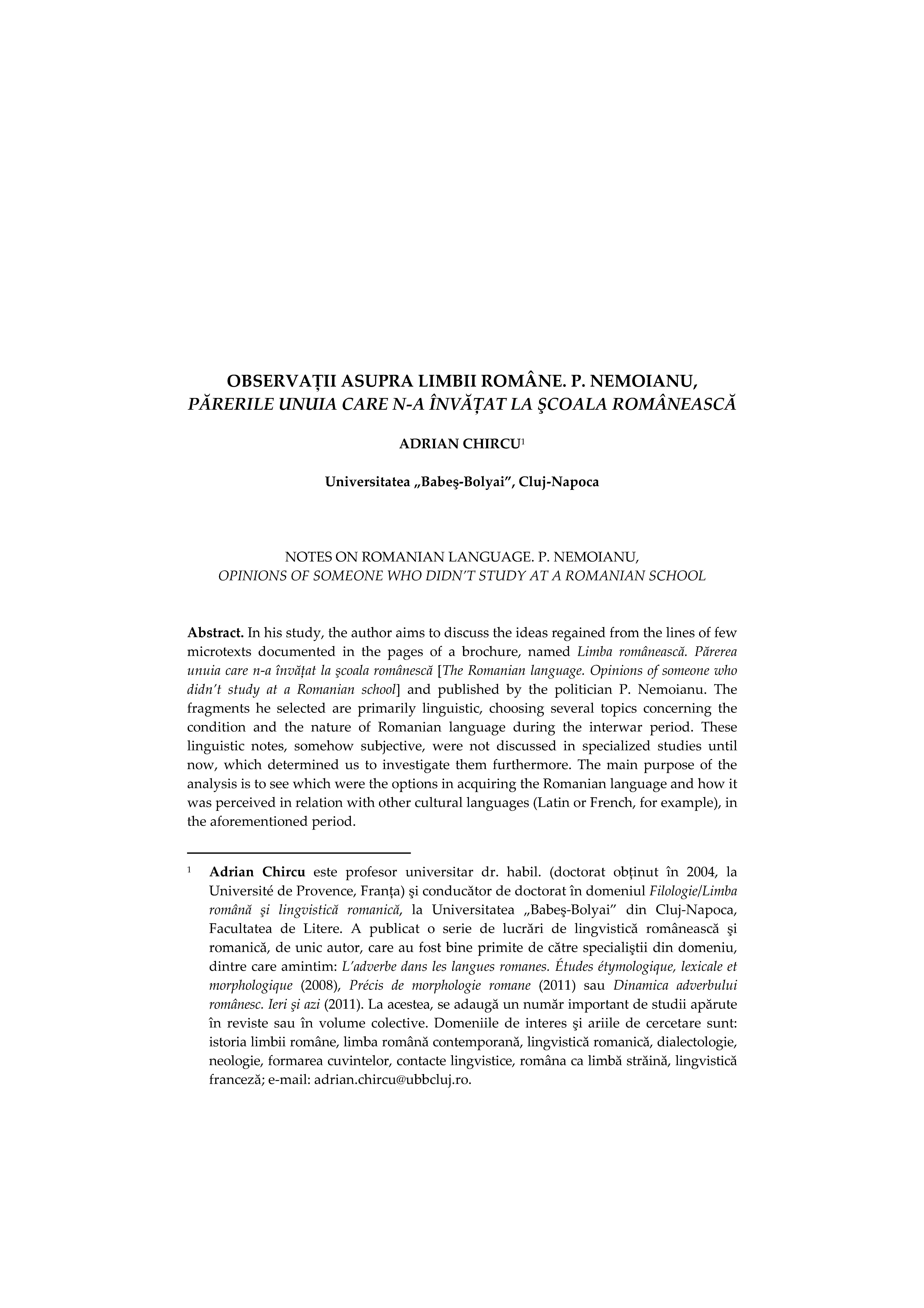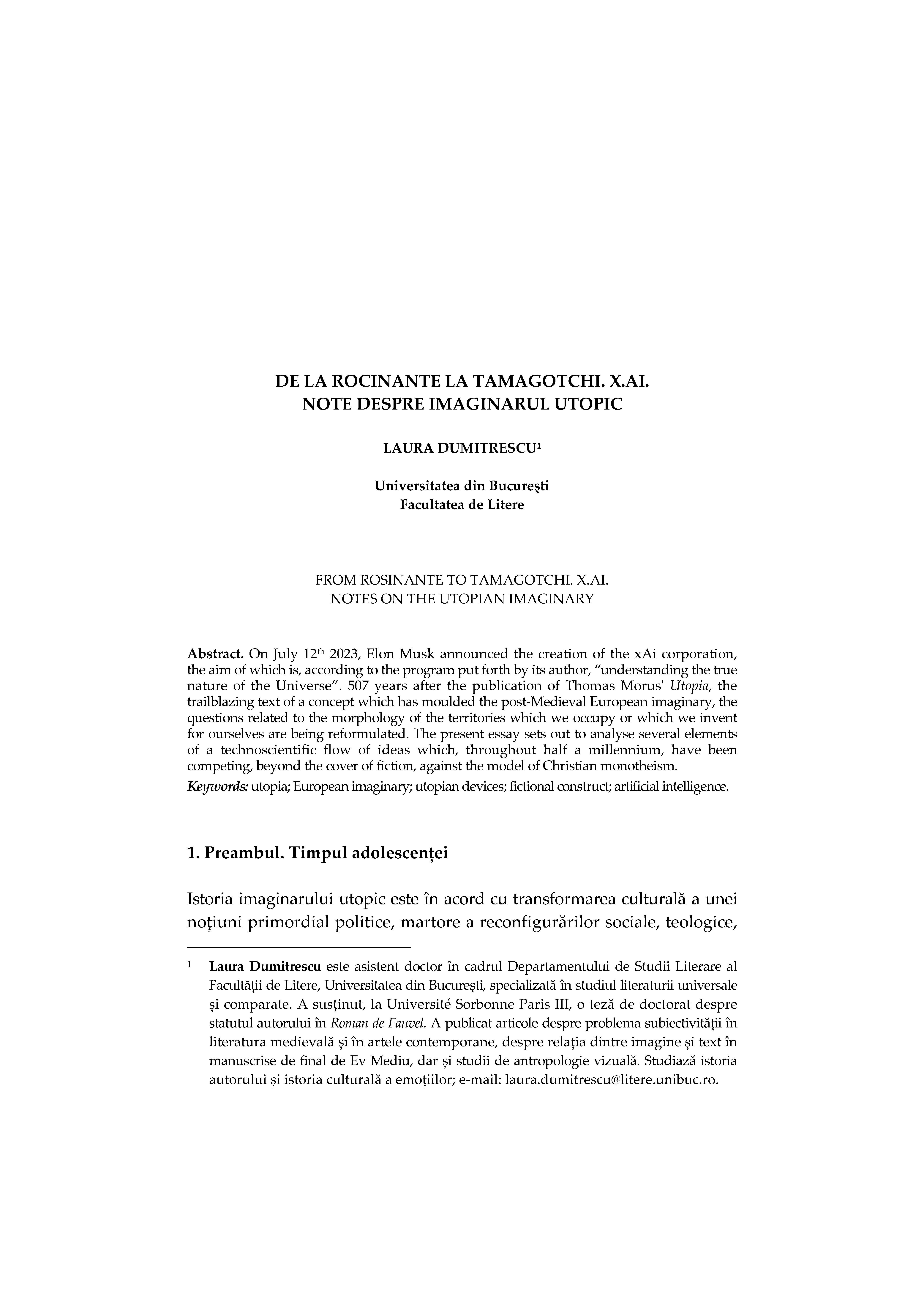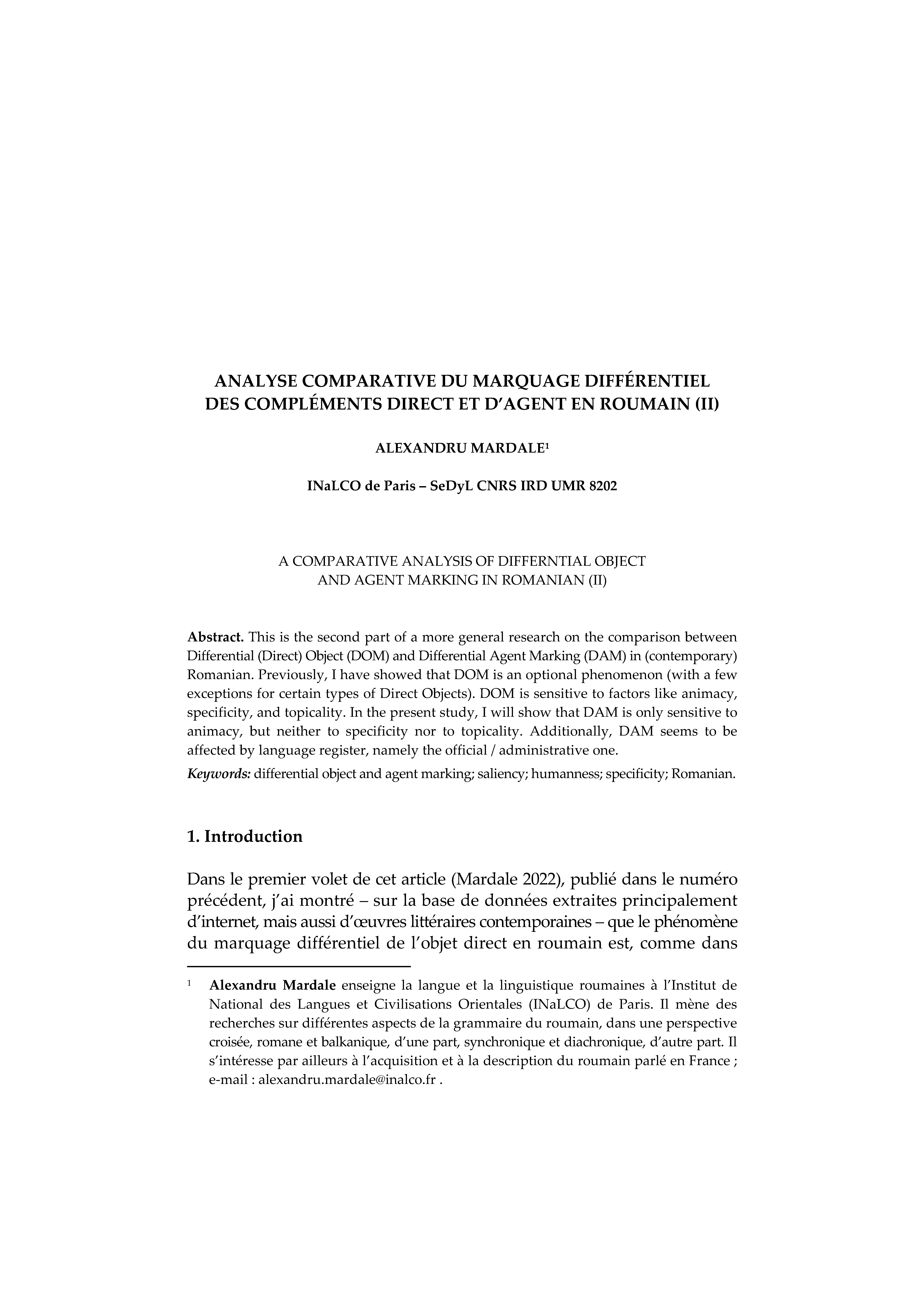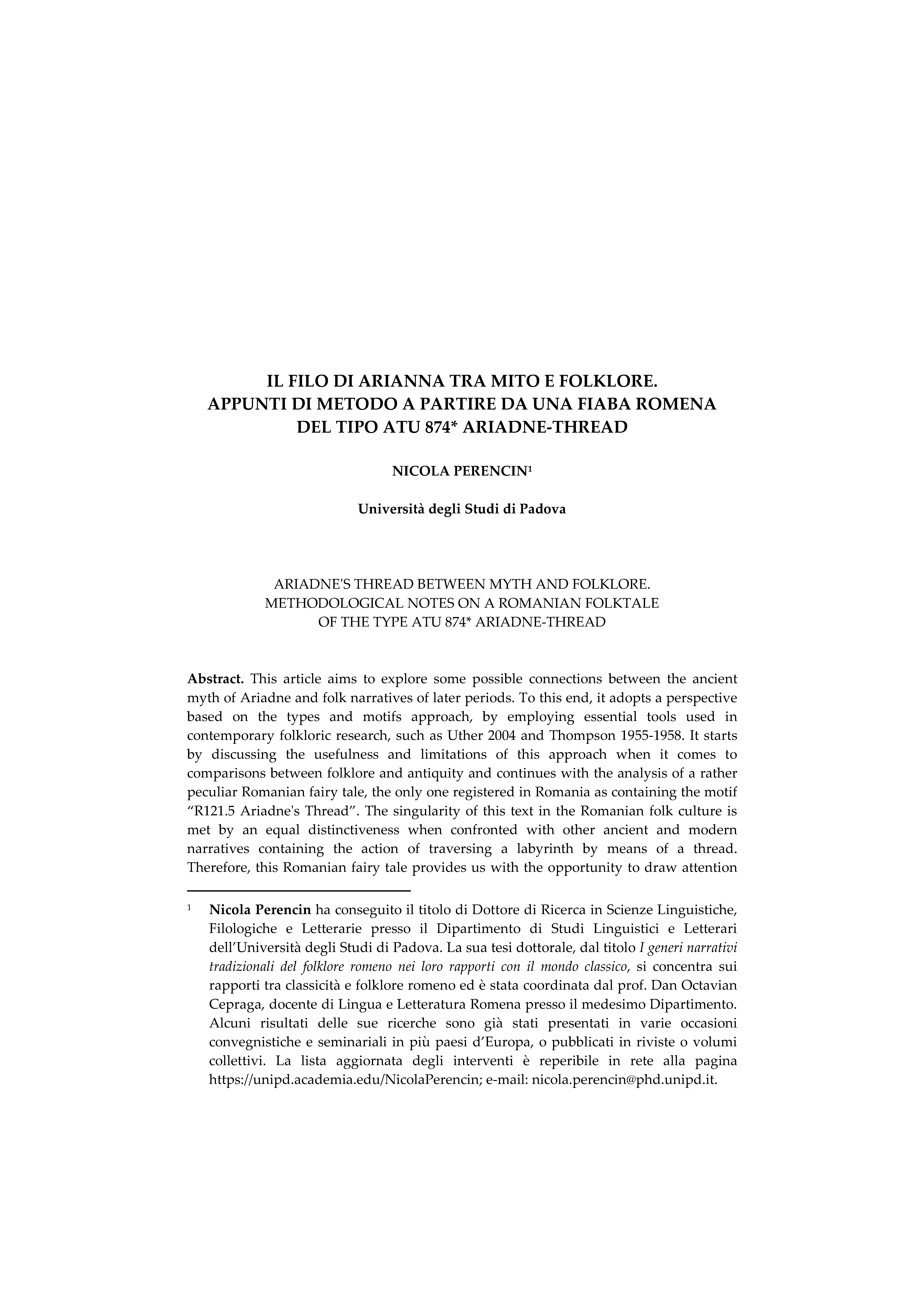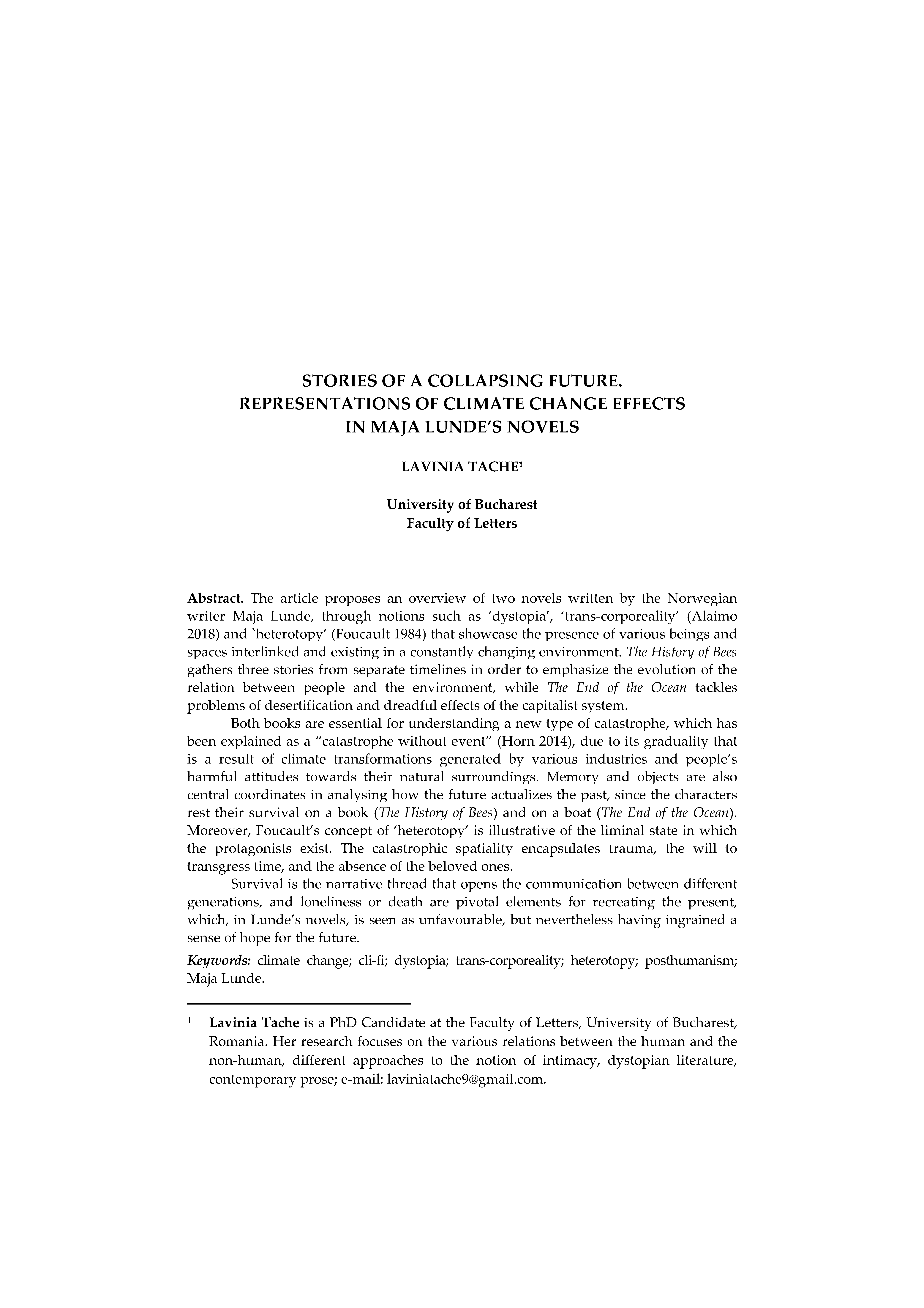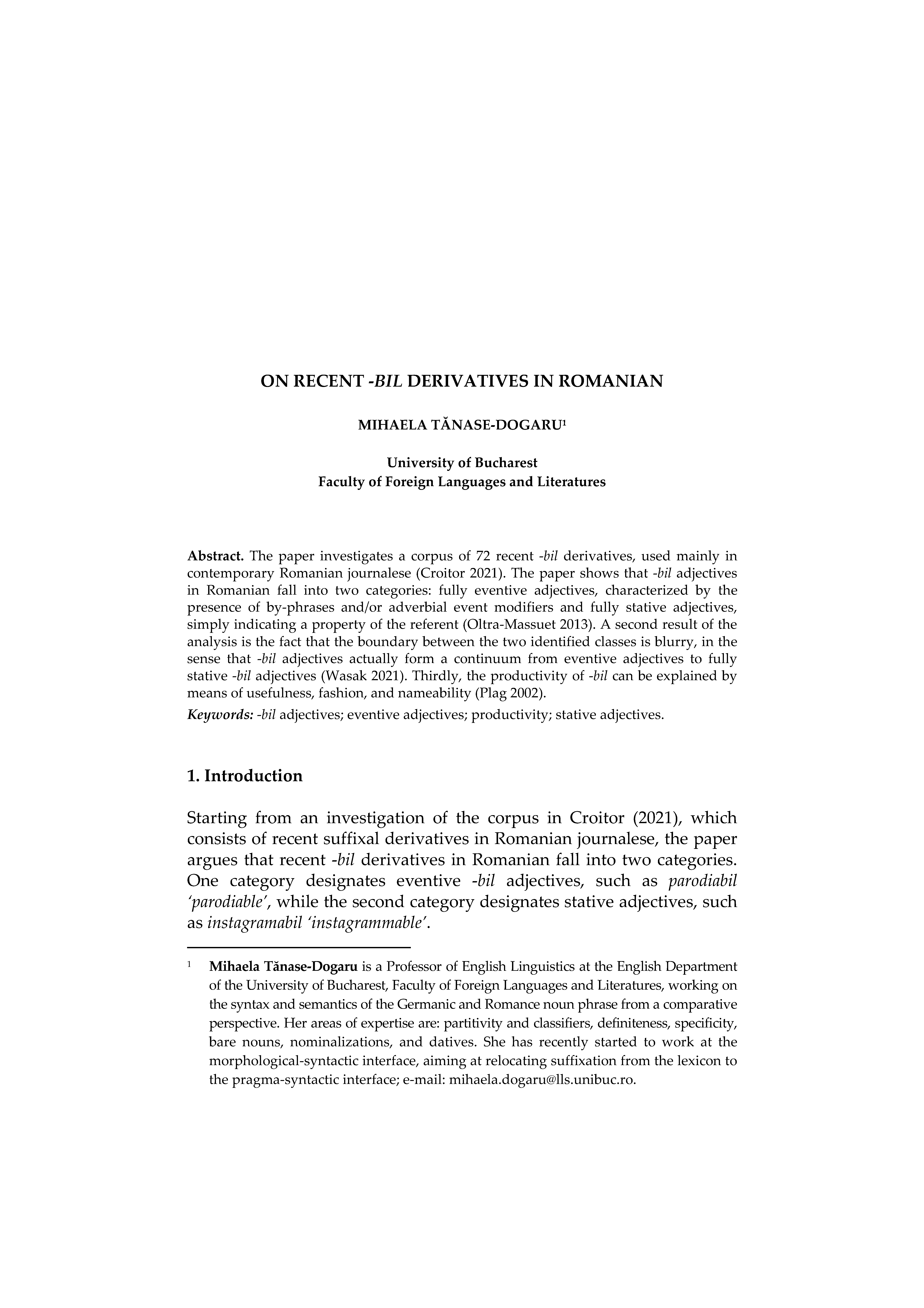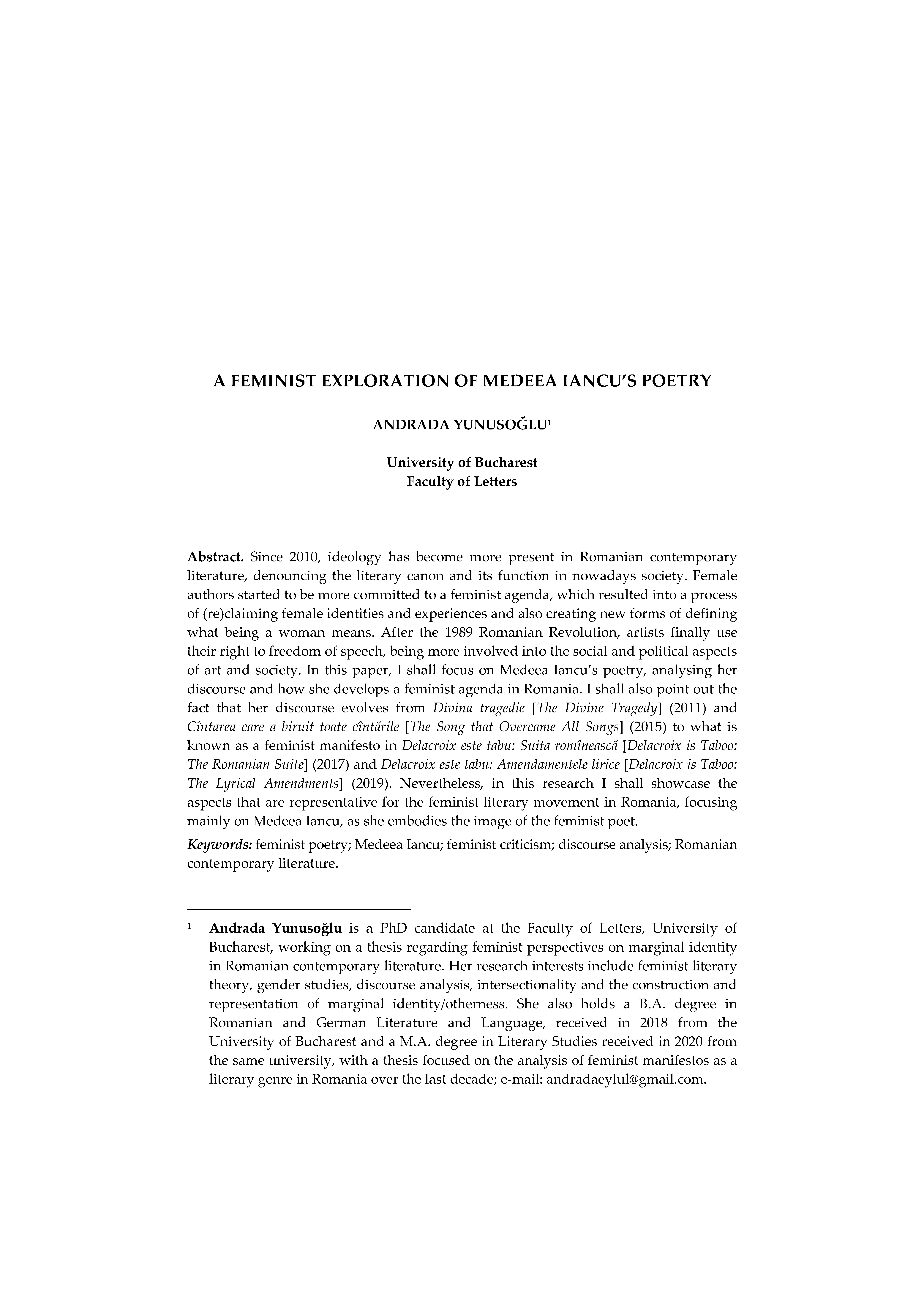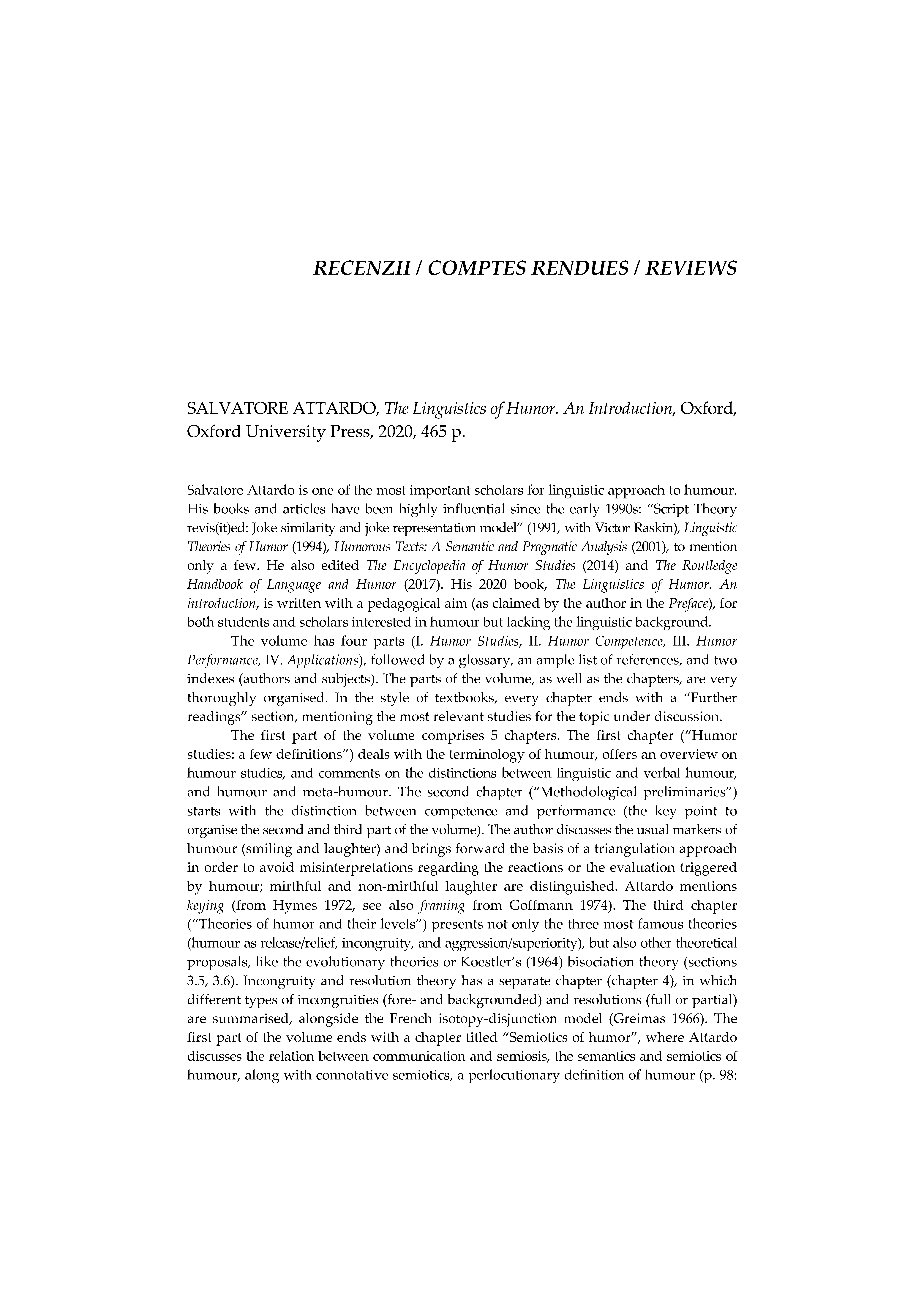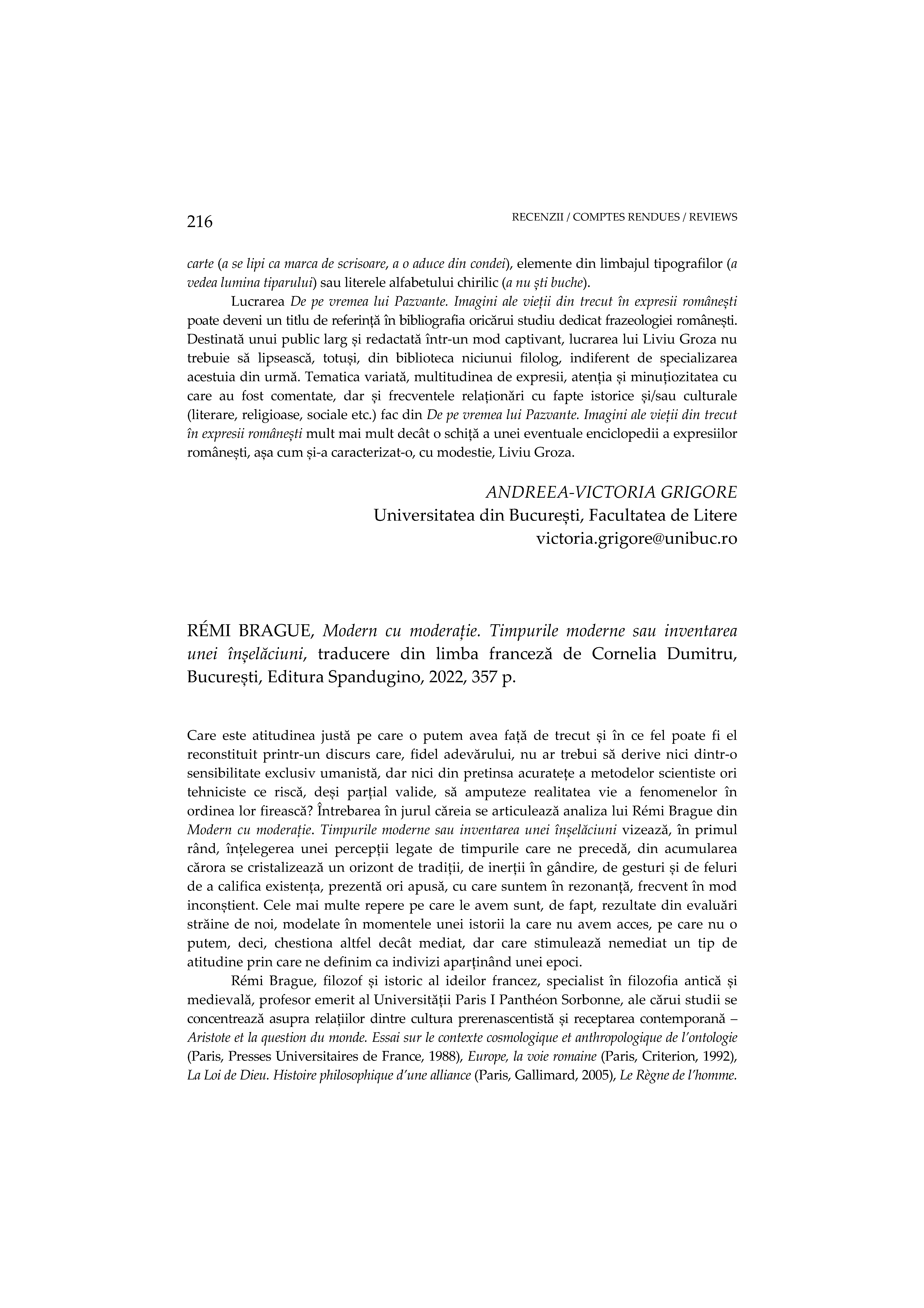Volum 72 Nr. 1 (2023): Analele Universității București. Limba și literatură română
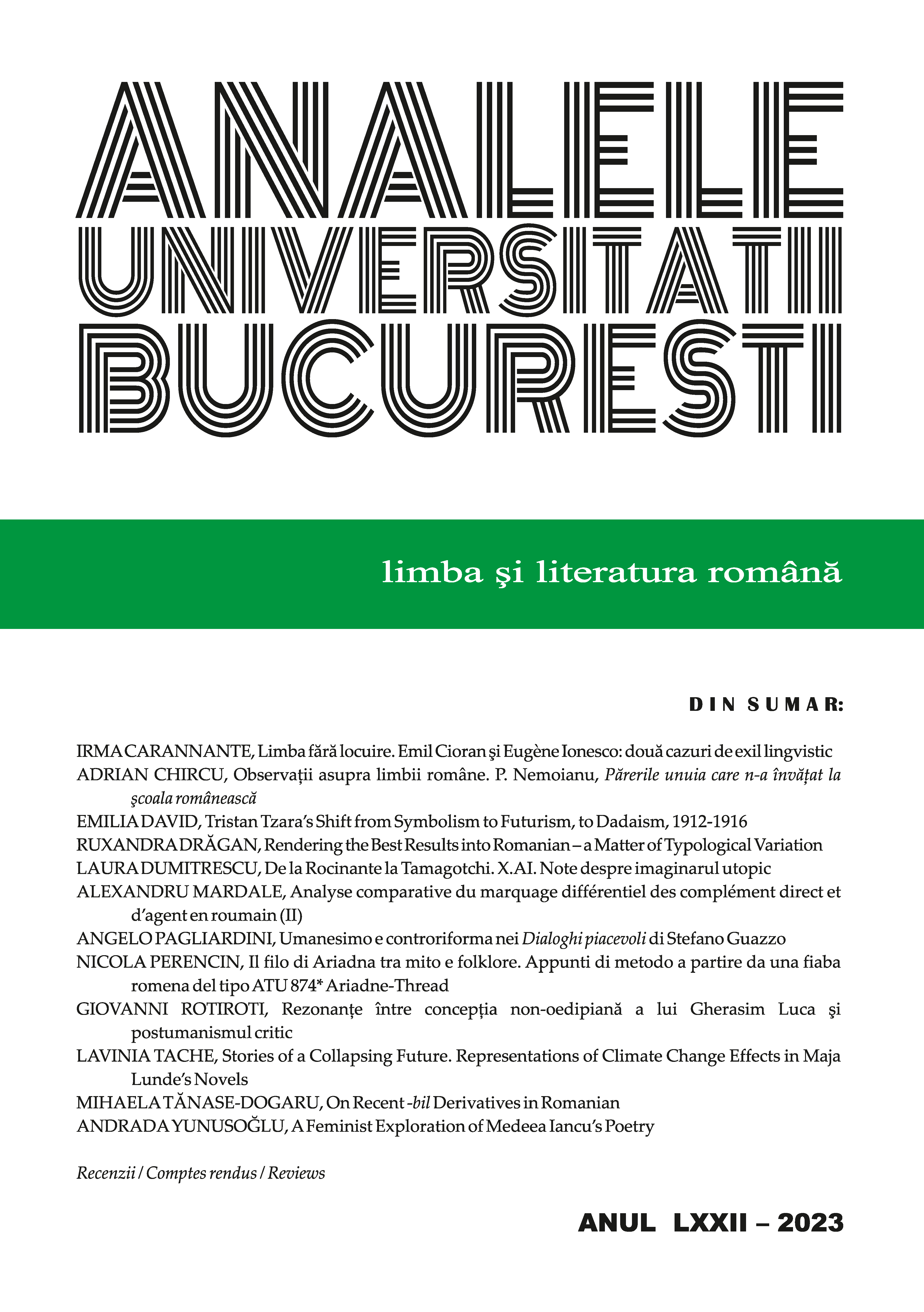
Revista publică articole şi recenzii care tratează teme de interes filologic din diverse domenii conexe: lingvistică privind româna și/sau alte limbi; literatură română; literatură universală şi comparată; teoria literaturii; folclor românesc şi comparat; antropologie culturală. Sunt încurajate, deopotrivă, cercetările din perspectivă pluri- și interdisciplinară, care plasează limba, literatura și cultura română într-un cadru de analiză extins, în acord cu dinamica cercetării științifice actuale din plan internațional.
Număr complet
Articles
-
LIMBA FĂRĂ LOCUIRE. EMIL CIORAN ȘI EUGÈNE IONESCO: DOUĂ CAZURI DE EXIL LINGVISTIC
Rezumat
This study aims to investigate the exile of Eugène Ionesco and Emil Cioran as a function of the linguistic modifications that occurred in their writing when they abandoned their homeland and their mother tongue, revolutionizing the ethical and aesthetic paradigms of the universal literary landscape. Dealing with their own history and making the repressed past re-emerge have allowed these authors to interrogate the present in the new language acquired starting from the Romanian-speaking literary space. This has led to various phenomena: transformations in the field of creation, starting from the break with the Romanian language, a subjective re-articulation in the field of the foreign language, starting from the triple psychoanalytic arrangement of the imaginary, the symbolic and the real, and the invention of new individualities and styles of thinking.
-
OBSERVAŢII ASUPRA LIMBII ROMÂNE. P. NEMOIANU, PĂRERILE UNUIA CARE N-A ÎNVĂŢAT LA ŞCOALA ROMÂNEASCĂ
Rezumat
In his study, the author aims to discuss the ideas regained from the lines of few microtexts documented in the pages of a brochure, named Limba românească. Părerea unuia care n-a învăţat la şcoala românescă [The Romanian language. Opinions of someone who didn’t study at a Romanian school] and published by the politician P. Nemoianu. The fragments he selected are primarily linguistic, choosing several topics concerning the condition and the nature of Romanian language during the interwar period. These linguistic notes, somehow subjective, were not discussed in specialized studies until now, which determined us to investigate them furthermore. The main purpose of the analysis is to see which were the options in acquiring the Romanian language and how it was perceived in relation with other cultural languages (Latin or French, for example), in the aforementioned period.
-
TRISTAN TZARA’S SHIFT FROM SYMBOLISM TO FUTURISM, TO DADAISM, 1912-1916
Rezumat
My paper will present Tristan Tzara’s artistic development from his early Symbolist days via Futurism to his Dadaist days in Zurich. In particular, I shall discuss how Futurism lingered on in the first phase of Dadaism and in Tzara’s Dada poetics
(1916-1918). I shall first analyse some traits of his Symbolist poetry, composed in the 1910s, until his departure from Romania. I shall argue that his orientation towards Futurism was possible thanks to his Symbolist beginnings, an aesthetic the young Tzara shared with many Futurists, including F.T. Marinetti. Following a reconsideration of the network of cultural relations forged by the Romanian writer between the young Dada
group in Zurich and members of the Futurist movement in Rome, Naples and Mantua,
or more precisely: between anti-Marinettian representatives of Futurism who edited the
magazines Noi, Le pagine, Procellaria and Brigata, I shall demonstrate that Tzara continued
to be open to Futurist influences, albeit from the Florentine and Ferrarese strands, which
were more moderate and less dogmatic than the Milanese circle around Marinetti.
Examining some Tzara works in Cabaret Voltaire and Dada, I shall demonstrate certain
Futurist affinities in his Dadaist production, in particular with regard to the graphictypographic
features of his poems and the performative tactics in his theatrical practice. -
RENDERING THE BEST RESULTS INTO ROMANIAN – A MATTER OF TYPOLOGICAL VARIATION
Rezumat
English (Germanic) and Romanian (Romance) are typologically different in the expression of both change-of-location and change-of-state events (cf. Talmy 1985, 2000). English favours Goal of Motion (GM) and resultative constructions, which combine
manner verbs with directional PPs and Result Phrases, respectively; Romanian typically opts for inherently directed motion and change-of-state verbs to achieve the same goals. At the same time, the existing typological differences have been shown to impact both the translation strategies rendering change events, and the syntactic structures they produce (Slobin 2004, 2005, 2006; Capelle 2012; Alonso 2018 et al.). The present article examines the strategies used by professional translators to translate resultatives into Romanian, and the resulting syntactic patterns, shown to be dependent on the type of resultative translated (fake/true). It demonstrates that the mostly compensatory techniques generate structures which, overall, reflect Talmy's lexicalization patterns for Romance and support the uniform treatment of GM and resultatives crosslinguistically.
It also argues that the higher syntactic/semantic variation of resultatives (vs. GM) is responsible for the higher number of strategies and patterns translating them. -
DE LA ROCINANTE LA TAMAGOTCHI. X.AI. NOTE DESPRE IMAGINARUL UTOPIC
Rezumat
On July 12th 2023, Elon Musk announced the creation of the xAi corporation, the aim of which is, according to the program put forth by its author, “understanding the true nature of the Universe”. 507 years after the publication of Thomas Morus' Utopia, the trailblazing text of a concept which has moulded the post-Medieval European imaginary, the questions related to the morphology of the territories which we occupy or which we invent for ourselves are being reformulated. The present essay sets out to analyse several elements of a technoscientific flow of ideas which, throughout half a millennium, have been competing, beyond the cover of fiction, against the model of Christian monotheism.
-
ANALYSE COMPARATIVE DU MARQUAGE DIFFÉRENTIEL DES COMPLÉMENTS DIRECT ET D’AGENT EN ROUMAIN (II)
Rezumat
This is the second part of a more general research on the comparison between Differential (Direct) Object (DOM) and Differential Agent Marking (DAM) in (contemporary) Romanian. Previously, I have showed that DOM is an optional phenomenon (with a few
exceptions for certain types of Direct Objects). DOM is sensitive to factors like animacy, specificity, and topicality. In the present study, I will show that DAM is only sensitive to animacy, but neither to specificity nor to topicality. Additionally, DAM seems to be
affected by language register, namely the official / administrative one. -
UMANESIMO E CONTRORIFORMA NEI DIALOGHI PIACEVOLI DI STEFANO GUAZZO
Rezumat
In 1586, the writer Stefano Guazzo publishes Dialoghi piacevoli. The treatise is made up of a collection of dialogues and has among its protagonists the “Prencipe della Valacchia Maggiore”, Petru Cercel, indicated as a model of the ideal prince. The work
was conceived during the implementation of the rules of the Council of Trent: that political, cultural, and religious system defined in historiography as the Counter-Reformation. Stefano Guazzo outlines the system of courts, in which the relations between the prince and courtiers are organised as a true “forma del vivere”. The writer constantly refers to the values and ideal questions of humanism, such as the formation of the prince and the courtier, or the relationship between letters and arms, according to the
writings of ancient Latin and Greek writers. At the same time, he has to adapt the thought and the literature of ancient writers with the principles imposed by the Counter- Reformation. In his book, one can also see an attempt to define the European space from Spain and France to Poland and Wallachia as Catholic. -
IL FILO DI ARIANNA TRA MITO E FOLKLORE. APPUNTI DI METODO A PARTIRE DA UNA FIABA ROMENA DEL TIPO ATU 874* ARIADNE-THREAD
Rezumat
This article aims to explore some possible connections between the ancient myth of Ariadne and folk narratives of later periods. To this end, it adopts a perspective based on the types and motifs approach, by employing essential tools used in contemporary folkloric research, such as Uther 2004 and Thompson 1955-1958. It starts by discussing the usefulness and limitations of this approach when it comes to comparisons between folklore and antiquity and continues with the analysis of a rather peculiar Romanian fairy tale, the only one registered in Romania as containing the motif “R121.5 Ariadne's Thread”. The singularity of this text in the Romanian folk culture is met by an equal distinctiveness when confronted with other ancient and modern narratives containing the action of traversing a labyrinth by means of a thread. Therefore, this Romanian fairy tale provides us with the opportunity to draw attention to some of the inconsistencies present in the typological approach commonly adopted by some recent studies dedicated to folklore in the ancient world. However, if we managed to resolve some of the problems inherent in the concept of type, the search for motivic similarities could stimulate a different kind of comparison between classics and folklore, thus opening the road towards new interpretations.
-
REZONANŢE ÎNTRE CONCEPŢIA NON-OEDIPIANĂ A LUI GHERASIM LUCA ȘI POSTUMANISMUL CRITIC
Rezumat
The article aims to point out that Gherasim Luca’s concept of non-oedipal existence resonates with the work of Gilles Deleuze and Félix Guattari, anticipating the nomad thought and the contemporary posthuman critical theory – as formulated by Rosi
Braidotti – centred on a critical posthumanism and an affirmative politics. The key-concept of Gherasim Luca, already present in his Romanian work, is that of “Non-Oedipus”. It’s a radical view of existence that anticipates by almost 30 years the theoretical achievements of Deleuze and Guattari’s works Anti-Oedipus and A Thousand Plateaus. -
STORIES OF A COLLAPSING FUTURE. REPRESENTATIONS OF CLIMATE CHANGE EFFECTS IN MAJA LUNDE’S NOVELS
Rezumat
The article proposes an overview of two novels written by the Norwegian writer Maja Lunde, through notions such as ‘dystopia’, ‘trans-corporeality’ (Alaimo 2018) and `heterotopy’ (Foucault 1984) that showcase the presence of various beings and spaces interlinked and existing in a constantly changing environment. The History of Bees gathers three stories from separate timelines in order to emphasize the evolution of the relation between people and the environment, while The End of the Ocean tackles
problems of desertification and dreadful effects of the capitalist system.
Both books are essential for understanding a new type of catastrophe, which has been explained as a “catastrophe without event” (Horn 2014), due to its graduality that is a result of climate transformations generated by various industries and people’s
harmful attitudes towards their natural surroundings. Memory and objects are also central coordinates in analysing how the future actualizes the past, since the characters rest their survival on a book (The History of Bees) and on a boat (The End of the Ocean). Moreover, Foucault’s concept of ‘heterotopy’ is illustrative of the liminal state in which the protagonists exist. The catastrophic spatiality encapsulates trauma, the will to transgress time, and the absence of the beloved ones.
Survival is the narrative thread that opens the communication between different generations, and loneliness or death are pivotal elements for recreating the present, which, in Lunde’s novels, is seen as unfavourable, but nevertheless having ingrained a
sense of hope for the future. -
ON RECENT -BIL DERIVATIVES IN ROMANIAN
Rezumat
The paper investigates a corpus of 72 recent -bil derivatives, used mainly in contemporary Romanian journalese (Croitor 2021). The paper shows that -bil adjectives in Romanian fall into two categories: fully eventive adjectives, characterized by the
presence of by-phrases and/or adverbial event modifiers and fully stative adjectives, simply indicating a property of the referent (Oltra-Massuet 2013). A second result of the analysis is the fact that the boundary between the two identified classes is blurry, in the sense that -bil adjectives actually form a continuum from eventive adjectives to fully stative -bil adjectives (Wasak 2021). Thirdly, the productivity of -bil can be explained by means of usefulness, fashion, and nameability (Plag 2002). -
A FEMINIST EXPLORATION OF MEDEEA IANCU’S POETRY
Rezumat
Since 2010, ideology has become more present in Romanian contemporary literature, denouncing the literary canon and its function in nowadays society. Female authors started to be more committed to a feminist agenda, which resulted into a process
of (re)claiming female identities and experiences and also creating new forms of defining what being a woman means. After the 1989 Romanian Revolution, artists finally use their right to freedom of speech, being more involved into the social and political aspects of art and society. In this paper, I shall focus on Medeea Iancu’s poetry, analysing her discourse and how she develops a feminist agenda in Romania. I shall also point out the fact that her discourse evolves from Divina tragedie [The Divine Tragedy] (2011) and Cîntarea care a biruit toate cîntările [The Song that Overcame All Songs] (2015) to what is known as a feminist manifesto in Delacroix este tabu: Suita romînească [Delacroix is Taboo: The Romanian Suite] (2017) and Delacroix este tabu: Amendamentele lirice [Delacroix is Taboo: The Lyrical Amendments] (2019). Nevertheless, in this research I shall showcase the
aspects that are representative for the feminist literary movement in Romania, focusing mainly on Medeea Iancu, as she embodies the image of the feminist poet.
Book Reviews
-
SALVATORE ATTARDO, The Linguistics of Humor. An Introduction Oxford, Oxford University Press, 2020, 465 p.
Rezumat
Salvatore Attardo is one of the most important scholars for linguistic approach to humour. His books and articles have been highly influential since the early 1990s: “Script Theory revis(it)ed: Joke similarity and joke representation model” (1991, with Victor Raskin), Linguistic Theories of Humor (1994), Humorous Texts: A Semantic and Pragmatic Analysis (2001), to mention
only a few. He also edited The Encyclopedia of Humor Studies (2014) and The Routledge Handbook of Language and Humor (2017). His 2020 book, The Linguistics of Humor. An introduction, is written with a pedagogical aim (as claimed by the author in the Preface), for both students and scholars interested in humour but lacking the linguistic background. -
LIVIU GROZA, De pe vremea lui Pazvante. Imagini ale vieţii din trecut în expresii românești București, Editura Vremea, 2022, 108 p.
Rezumat
Lucrarea De pe vremea lui Pazvante. Imagini ale vieţii din trecut în expresii românești face parte din categoria studiilor dedicate de către Liviu Groza frazeologiei limbii române. Un domeniu lingvistic bine delimitat și de actualitate, frazeologia reprezintă o temă pe cât de interesantă, pe atât de dragă profesorului Groza, care a abordat-o nu numai în numeroase contribuţii știinţifice publicate în ţară și în străinătate, ci și în timpul prelegerilor de la cursul Frazeologie românească, ţinut pentru aproape douăzeci de ani la masteratul de limba română de la Facultatea de Litere (Universitatea din București).
-
RÉMI BRAGUE, Modern cu moderaţie. Timpurile moderne sau inventarea unei înșelăciuni traducere din limba franceză de Cornelia Dumitru, București, Editura Spandugino, 2022, 357 p.
Rezumat
Care este atitudinea justă pe care o putem avea faţă de trecut și în ce fel poate fi el reconstituit printr-un discurs care, fidel adevărului, nu ar trebui să derive nici dintr-o sensibilitate exclusiv umanistă, dar nici din pretinsa acurateţe a metodelor scientiste ori tehniciste ce riscă, deși parţial valide, să amputeze realitatea vie a fenomenelor în ordinea lor firească? Întrebarea în jurul căreia se articulează analiza lui Rémi Brague din Modern cu moderaţie. Timpurile moderne sau inventarea unei înșelăciuni vizează, în primul rând, înţelegerea unei percepţii legate de timpurile care ne precedă, din acumularea cărora se cristalizează un orizont de tradiţii, de inerţii în gândire, de gesturi și de feluri de a califica existenţa, prezentă ori apusă, cu care suntem în rezonanţă, frecvent în mod inconștient. Cele mai multe repere pe care le avem sunt, de fapt, rezultate din evaluări străine de noi, modelate în momentele unei istorii la care nu avem acces, pe care nu o putem, deci, chestiona altfel decât mediat, dar care stimulează nemediat un tip de atitudine prin care ne definim ca indivizi aparţinând unei epoci.


